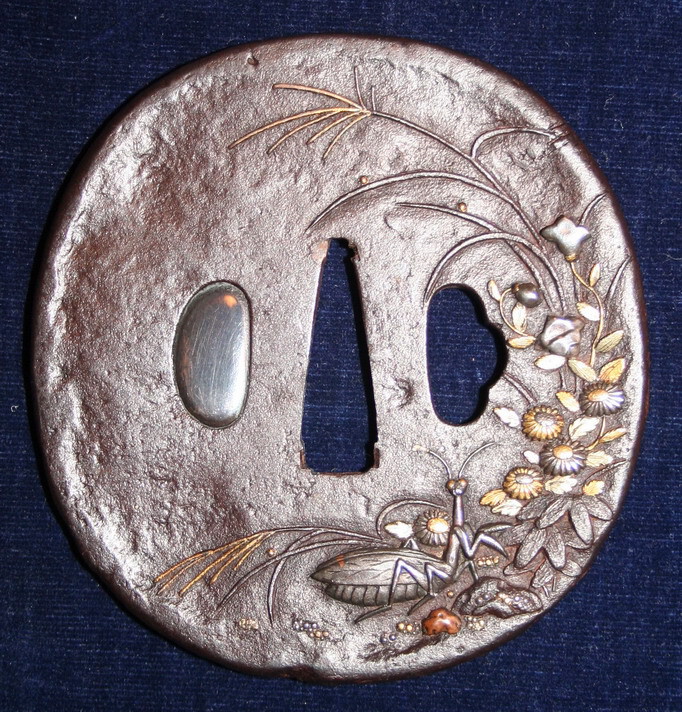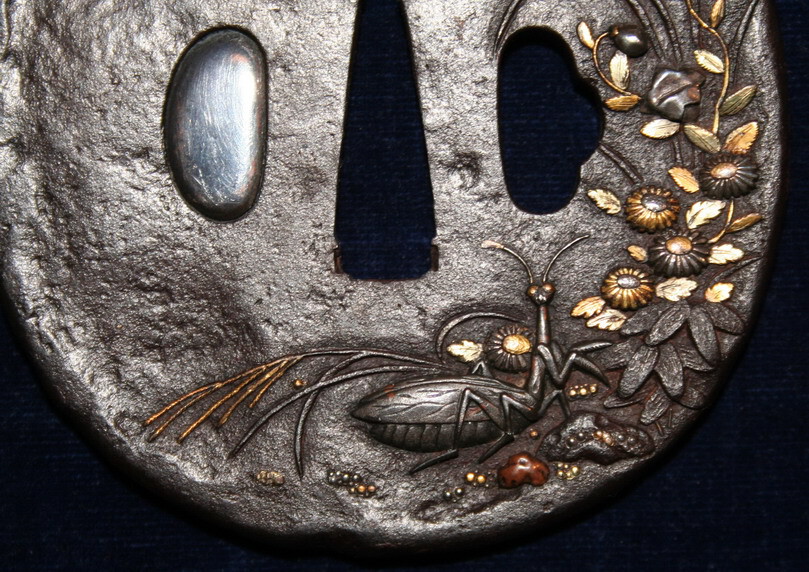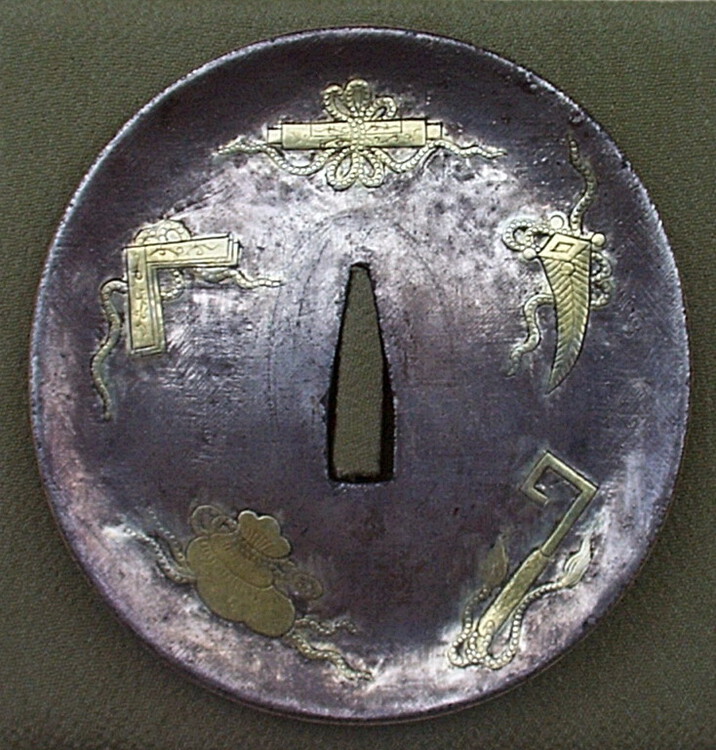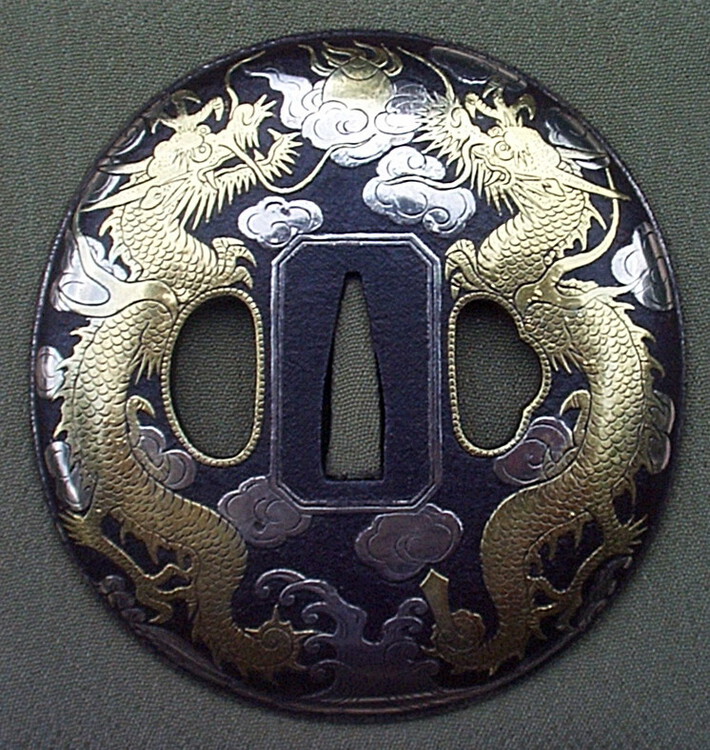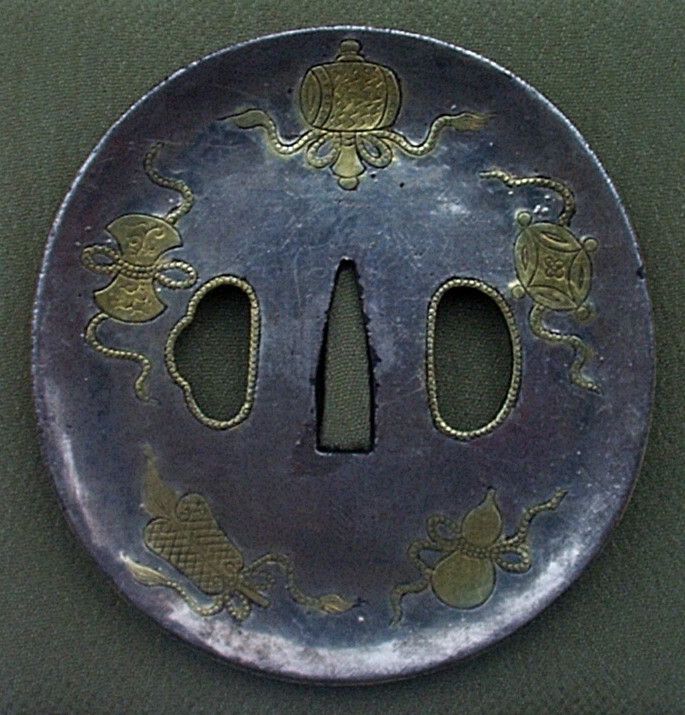-
Posts
2,820 -
Joined
-
Last visited
-
Days Won
27
Content Type
Profiles
Forums
Events
Store
Downloads
Gallery
Everything posted by Bazza
-
OK All, The image I particularly wanted to show for Bruno as to quality urushi (traditional lacquer) finish on shingunto swords is this one: The rest of the sword is off-topic and I'll post those on the Board index » Nihonto Discussion list under a new thread UNUSUAL SHINGUNTO. George, I also have a damaged Shingunto lacquered saya that is damaged and shows the cloth underneath the lacquer. Bruno, all this is to say that your "green" scabbards look to be traditional lacquer and should be preserved as such. Best regards, Barry Thomas.
-
Dear Old George - make sure you have company if you venture out into the dark!!! Your comments encourage me to put here for your attention an extremely interesting Shingunto with ishime urushi saya that I catalogued for an auction here some 18 months ago. I would love to have bought it, but I had already savagely abused my credit card on sundry other Edo-malia!! However, the night is late and I'm knackered (Aussie expression for "tired beyond belief"), so I'll attend to it tomorrow - watch this space. Best regards, Barry Thomas.
-
G'day All, Ahhh, the first mention of "ishime". Firstly, most of the blades (sample of about 6 swords) I have seen in these mounts have been better class gendaito, and if not "good" then named smiths "in the books" and not poorer factory productions. Secondly, this seems a good time and place to ask my question about the green scabbards of "ishime". I have also seen this finish on the more normal Shingunto as well. It appears to me to be genuine urushi, that is to say, real ishime lacquer, the same as on katana of old. In which case, Bruno, I opine that this is a very expensive finish in its day and very traditional. To even think of taking it off amounts to a heinous crime IMHO. I have seen nothing in print about these ishime scabbards and would love to hear the opinions of others. Best regards, Barry Thomas.
-
Could I be bold enough to say this has a "modern" look?? Perhaps early 20th century??? No analysis here, no books, just a certain "look" about it compared to my "memory bank average" of many years... On the colour difference observed. Discussion here has talked about the complexities of colour calibration in monitors and digital photography. I can only think of white balance vis-a-vis light source???? Best regards, Barry Thomas (Melbourne, Australia)
-
Dear Brethren, This is a lovely koshirae Ford. Meiji period??? I did a google search using keywords [ baleen buying ] and turned up this very interesting thread: http://www.city-data.com/forum/alaska/3 ... aleen.html So I guess baleen is available if one looks hard enough. I think I might have some pics somewhere of another koshirae - if I find it I'll put it up. Regards, Barry Thomas
-

Translation assistance on Chinese Auction (?)
Bazza replied to SwordGuyJoe's topic in Translation Assistance
Koichi san's image of So Tsutomu compared to the "China" auction sword nakago shows how difficult it is to do yasurime artfully. Regards, Barry Thomas. -

help needed with a mei that endds in mitsu
Bazza replied to b.hennick's topic in Translation Assistance
Barry H, Off the top of my head - UJI MITSU??? Barry Thomas. -
G'day All, I would be equally interested in a list of Mukansa polishers. Always the polisher is the shadow behind the smith, or so it appears to me in this Nihonto backwater. I imagine that in Japan the polishers are as well known as the smiths??? Regards, Barry Thomas.
-
G'day All, I particularly enjoyed Ford's discourse on the aesthetics of the Kanji and Markus' additional information. I thought of the beautiful inscriptions we find on Meiji metalwork where the chisel work takes one's breath away. Of course, one can follow lines of discussion to the nth degree, but I did find a further comment on Reisho script that i thought was useful: http://www.stockkanji.com/info/Glossary.htm "Reisho (Clerical Script) is a simplified version of the tensho script that is dominated by horizontal and vertical lines. This is sometimes called the "Clerical Script" and in the Han Dynasty (206BC - 220AD) served to simplify the tensho script and therefore make it more appropriate for practical purposes. The overall shape is rectangular with a height to width ration of two to three. Today this simplified version of the tensho style is used only for newspaper names and in stone carving (e.g. grave markers)." Regards, Barry Thomas.
-
Ken, I recently found a tsuba with your favourite theme. A friend has a Kanesada katana with a mantis theme iron tsuba. Not strictly Heianjo, but as this thread seems to have worn itself out thought I'd just put it here for your benefit Old Mate. Now, I'm not a tsuba man so would appreciate comments anyone cares to make. IMHO this is a very good tsuba, noting the finely worked coloured metal inlays in the body and neck of the mantis as well as the "red rock" in the foreground. The sculpted surface of the tsuba with a barely discernible mimi has a good aesthetic feel. I apologise for the "hard" looking surface due to the flash lighting, but I had only a brief opportunity to take the pic. Best regards, Barry Thomas.
-

samurai sword 1450-1550 a.d.
Bazza replied to snatch13's topic in General Nihonto Related Discussion
After all that has been said, mostly to good advantage for the persistent reader, I come back to my first feeling on viewing the fuzzy photo of the putative shumei. I thought (as someone else commented) that the lacquer looked "fresh" (synonym "new") and very much the wrong colour, as if a 'modern' aniline dye/pigment was used in the urushi instead of the cinnabar of old (red mercury sulfide (HgS), or native vermillion). The sword itself could of course be polished and put to Shinsa without removing the shumei, then removing it if and only if the Shinsa result was divergent. I learnt some fine points in this protracted thread, as I hope some of the participants did!! Regards, Barry Thomas. -
I'm staggered by the similarity to my Namban tsuba already presented. The 'proof of the pudding' would be in the shape of the nakago ana and there is no doubt that my tsuba is Japanese in that regard. I would speculate that the Tibetan sword (a friend once owned a very good one) would have a rectangular tang - is there then any connection between a Tibetan rectangular tang and the rectangular seppa dai on a Namban tsuba?? I imagine Tibetan 'Namban' tsuba would be very rare in Japan, so perhaps they inspired copies more in the Japanese style for katana??? Regards, Barry Thomas.
-
To add a little more to this very interesting thread, but first, on Sun Jun 14, 2009 9:54 am Piers wrote: > Some time ago, Barry asked me to post hi-res pics of this Namban tsuba, > (the only one I have, likewise) and I did, but never found out why. Piers, sorry about that. I just simply lost track of it in a busy life, but I certainly recall asking the question. It was simply to add a higher resolution image to my files on Namban tsuba. Earlier, on Sun Jun 14, 2009 7:10 am Dr John L wrote in response to my statement that I thought the NBTHK had attributed my tsuba to 17th century: > But C17? The concavo-convex profile that Barry describes indicates to me > a European influence and a possibly rather later date of manufacture. It only then struck me that with all the gold and quality could Genroku be a reasonable period to attribute its creation??? To add to the concavo-convex profile I submit images of a daisho tsuba. Probably not Namban, but almost certainly Hizen??? The images clearly show that the tsuba have been mounted on koshirae at some time, as 'normal shaped' seppa wear patterns are evident. How the front of the tsuba with the rectangular Namban-style seppa dai were fitted begs the question and harks to Reinhard's question about such tsuba being made by "...people who did not know Nihonto". I would suggest these tsuba are of the highest quality workmanship, which still leaves us with Reinhard's question... Regards, Barry Thomas.
-
Reading this thread I realise how little I know about Namban tsuba - but then, I'm a "blade man'!! For "SHOW AND TELL" I've put two images of my one and only Namban tsuba below. It is 83mm high x 75mm wide x 6.5mm thick. In the first NBTHK Shinsa in the USA it was given a Tokubetsu Kicho paper and noted (if my memory of 40-ish years ago serves me correctly) as 17th century. A polisher from Japan looked at it a few years ago and said "A real one!" He knew what "Namban" meant to him, but in the line of a comment above, does it relate to what Namban meant in the early Edo period?? This tsuba is particularly interesting I feel because the front is convex. The seppa dai and the dragons and scroll work are in a flat plane, but the rim containing the two dragons and scroll work is about 1mm below the flat plane, and the inside bound of the outer border beading is about 2mm below the flat. The gilt plate on the front seppai dai is loose and when removed reveals an abstract cloud pattern sunk below the flat plane by the thickness of the gilt plate, suggesting this was an original design feature? Given the erudite comments here about "the artist's intention" I am bereft of any comments and look forward to the collective opinion on this tsuba. On Chriso's question "is anyone aware of any other publications on Nanban????" I have not seen any discussion on the merits of Boxer's article in the Transactions of the Japan Society, London. The only comment I recall without reading it all again is that a beaded rim indicates an earlier piece. Anyone?? Regards, Barry Thomas.
-
Mark, Piers, All, I once had a sankaku yari mounted as an aikuchi tanto, the blade being only 4 or so inches long. The nakago had been cut, of course, but the mei SHIMOSAKA was still evident. Now, it is true that I have never seen another one (maybe one other??). Edo?? Whilst the yari itself was no doubt old, the aikuchi tanto koshirae I thought was perhaps Meiji although of course it could have been late Edo. It was a somewhat poor quality affair and my feeling at the time was that it was a cheap way for someone to have a defensive weapon, a tanto blade almost certainly being more expensive than a by then more-or-less useless short yari, of which I'm sure there were thousands freely available. Maybe they are "rare" in Japan because they were mostly sold as curios in the Meiji period?? Regards, Barry Thomas.
-
Could the pumpkin be the Chinese Bell Flower Platycodon grandiflora, aka the Japanese Bell Flower or the Balloon Flower????? Regards, Barry Thomas.
-
Genji Mon go back to the Heian Period http://www.viewingjapaneseprints.net/te ... imon7.html QUOTE "Genji crests (genji-mon) or Genji incense (genji-kô) were emblems associated with the 54 chapters of the Genji monogatari ("The Tale of Genji"), written by Murasaki Shikibu in the first quarter of the eleventh century" END QUOTE. Regards, Barry Thomas.
-
To me the style of kanji on both the subject sword and the ...Naritsugu... found by Koichi san are both WW2 Showa swords??? We wouldn't expect to find these in the Meikan - Fuller and Gregory maybe??? Regards, Barry Thomas.
-
G'day All, I know, I know, as if we don't have enough stuff to wade through - but - I enjoyed the discussions here with some familiar names from this esteemed forum of ours: http://www.aikiweb.com/forums/showthread.php?t=14957 I hope others agree. Regards, Barry Thomas.
-
Before I get to the business of the day (good grief, it's 12.45pm already!!), with regard to the "small horse" I recall seeing two suits of armour here in Oz that a dealer had imported from Japan. They truly looked like child's armour!! So, apart from giants such as Yoshitsune's companion Benkei, it might appear that the average samurai of the day was well-suited (pun??!!) to his horse. Regards, Barry Thomas.
-
Thank you all for a thoroughly interesting and absorbing thread. Re the quote above, the wording suggests Western 'smiths', but I'm pretty sure that I have seen a Japanese drawing of an artisan pulling wire through a hole in a steel plate. Can anyone else confirm this??? If I'm efficient, tomorrow (it's near midnight here in eastern Oz) I'll photograph my Yoshiro zogan tsuba and put it here. Regards, Barry Thomas.
-
I'm sure that an in-hand inspection would confirm the mounts to be modern copies for anyone familiar with the real thing. In this case the "kaigunto" is actually a Shingunto copy I think... Guido's report gives real cause for concern for anyone not yet "up to speed" on the real thing. Therefore for anyone reading this thread the extreme exhortation is to buy books before swords and see as many of the real thing in museums and collectors' hands before even thinking of buying a sword. Increasingly, all collecting Japanese swords seems to be costing some people is grief and money. For anyone faintly serious about collecting Nihonto as a lifelong interest, they would be infinitely better off by visiting Japan... The cost can truly be classed as "paying your dues" and may, in fact, save far more money in the future. Remember, at even a reasonable level of quality the costs are very high, let alone high quality items. Best regards, Barry Thomas.
-
IS THERE A MILT IN THE HOUSE?????!!!! Bazza.
-
I recall reading a couple of decades ago that the auction houses of Europe were full of (enthusiastically??) over-restored tsuba... Having seen a few efforts along these lines I agree with the view that you might regret it once it's done. It's not only the metal composition it's the centuries of age and patina that can't be recreated. I have an iron Yoshiro zogan tsuba with bits of brass wire inlay missing and in less than pristine condition that has an old NBTHK green paper (Tokubetsu Kicho) from the first NBTHK Shinsa in the USA - mmmmm - maybe nearly forty years ago. I haven't touched it even to clean it, because once it is done it cannot be undone. Maybe a next-generation collector will have more knowledge. The Greeks have a word for this sort of thing - hubris. I think it fits here nicely. Having said that, I am aware that there are professional (iron? Shakudo?? Shibuichi???) tsuba restorers in Japan. Anyone know anything about them??? Barry Thomas.


